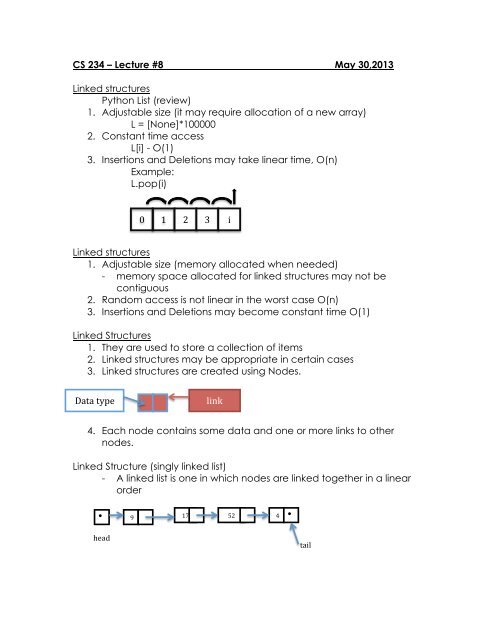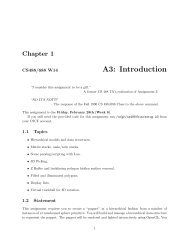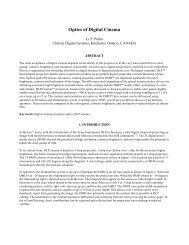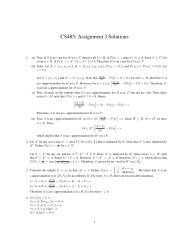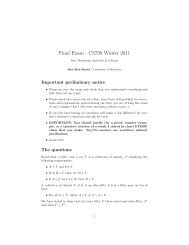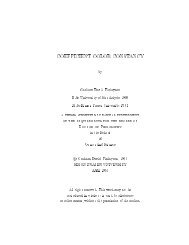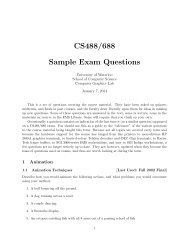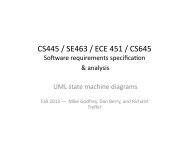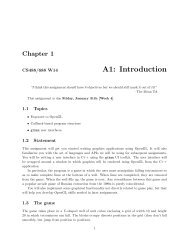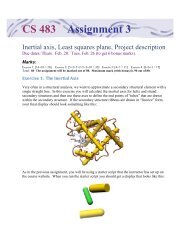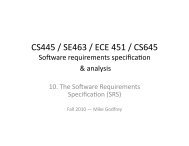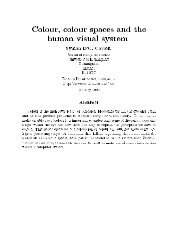Arete Zafiriou - Student.cs.uwaterloo.ca
Arete Zafiriou - Student.cs.uwaterloo.ca
Arete Zafiriou - Student.cs.uwaterloo.ca
You also want an ePaper? Increase the reach of your titles
YUMPU automatically turns print PDFs into web optimized ePapers that Google loves.
CS 234 – Lecture #8 May 30,2013<br />
Linked structures<br />
Python List (review)<br />
1. Adjustable size (it may require allo<strong>ca</strong>tion of a new array)<br />
L = [None]*100000<br />
2. Constant time access<br />
L[i] - O(1)<br />
3. Insertions and Deletions may take linear time, O(n)<br />
Example:<br />
L.pop(i)<br />
0 1 2 3 i <br />
Linked structures<br />
1. Adjustable size (memory allo<strong>ca</strong>ted when needed)<br />
- memory space allo<strong>ca</strong>ted for linked structures may not be<br />
contiguous<br />
2. Random access is not linear in the worst <strong>ca</strong>se O(n)<br />
3. Insertions and Deletions may become constant time O(1)<br />
Linked Structures<br />
1. They are used to store a collection of items<br />
2. Linked structures may be appropriate in certain <strong>ca</strong>ses<br />
3. Linked structures are created using Nodes.<br />
Data type <br />
link <br />
4. Each node contains some data and one or more links to other<br />
nodes.<br />
Linked Structure (singly linked list)<br />
- A linked list is one in which nodes are linked together in a linear<br />
order<br />
<br />
9 <br />
17 52 4 <br />
<br />
head <br />
tail
head – reference to the first node in the list<br />
tail – last node in the list<br />
link in the tail is a None reference<br />
Most nodes have no names or references.<br />
They are referenced by the link in the preceding node.<br />
Head – should be referenced by an external variable<br />
- entry point to the list<br />
- null head reference indi<strong>ca</strong>tes an empty list<br />
The Basic operations<br />
1. List traversal<br />
2. Search for an item<br />
3. Insert an item<br />
4. Delete an item<br />
…<br />
Traversing a List<br />
curNode <br />
<br />
9 17 52 4 <br />
We <strong>ca</strong>n traverse this list by creating a temporary reference<br />
curNode = head<br />
<br />
9 14 17 52 <br />
create a linked list<br />
LL = Node(9, Node(14,Node(17,Node(52,None))))<br />
N = Node(23)<br />
23 <br />
<br />
Traverse the list by advancing the temporary reference<br />
curNode = curNode._next<br />
Repeat again
Until Curnode == None, you have reached the end of the list<br />
<br />
23 <br />
9 14 17 <br />
Searching for an item in SLL<br />
Traverse the list<br />
Produce true if the item is in the list<br />
Produce false otherwise<br />
Inserting items in a SLL<br />
Insert(27)<br />
Node<br />
17 <br />
head <br />
Beginning of the list<br />
head <br />
New node<br />
27 <br />
17 <br />
newNode._next = head<br />
head = newNode<br />
1. newNode._next=head<br />
head = newNode<br />
2. head=newNode<br />
newNode._next = head<br />
Inserting in the middle of the list<br />
<br />
9 <br />
17 14 52 <br />
1 <br />
2 <br />
curNode 27 <br />
newNode
1) NewNode._next = curNode._next<br />
curNode._next = newNode<br />
Insert at the end of the list as an exercise.<br />
Removing an item from SLL<br />
Search for the item that we want to remove<br />
remove(17) predNode._next = curNode.next<br />
curNode._next = None<br />
9 14 17 52 <br />
<br />
<br />
head predNode curNode <br />
deleting the head of the SLL<br />
9 14 17 52 <br />
<br />
preNode <br />
head <br />
curNode <br />
head = head._next<br />
curNode._next = None<br />
We need to update the head in this <strong>ca</strong>se<br />
ADT sequence<br />
Data: linear collection of items<br />
Operations:<br />
Sequence()<br />
__repr__<br />
__getItem__<br />
len<br />
append<br />
insert<br />
extend<br />
pop<br />
remove<br />
reverse<br />
Implement this ADT using SLL
Python List<br />
__getItem__(self,index)<br />
L[i]<br />
Variations of Linked Lists<br />
Circularly linked lists<br />
SLL<br />
entry <br />
9 14 <br />
<br />
17 <br />
52 <br />
Doubly Linked lists<br />
<br />
9 14 17 52 <br />
Forward and Backward traversals<br />
Issues:<br />
- Efficiency of Operations<br />
- Memory requirements<br />
Linked Structures do not have to be linear<br />
15 <br />
71 <br />
55 <br />
<br />
21 <br />
57 <br />
17 <br />
91 <br />
52


